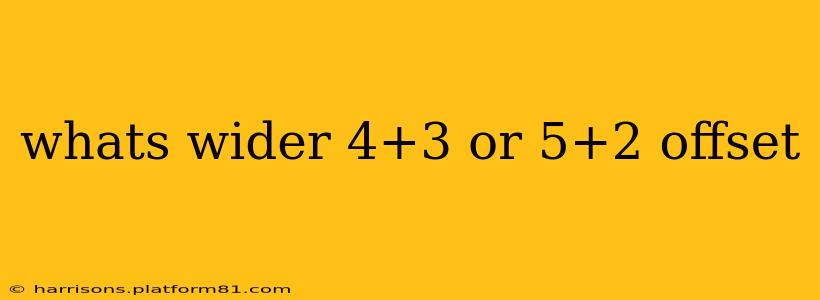Understanding Wheel Offset: 4+3 vs. 5+2
When it comes to choosing the right wheels for your car, understanding offset is crucial. Offset refers to the distance between the wheel's mounting surface and its centerline. A positive offset means the mounting surface is closer to the outside of the wheel, while a negative offset pushes it inward. Let's break down the difference between a 4+3 and a 5+2 offset to determine which is wider.
What do 4+3 and 5+2 represent?
These numbers represent the wheel's offset in a specific system of measurement, likely millimeters. The first number represents the total wheel width, while the second represents the offset itself. However, this is a non-standard way of representing offset, and in practice offset is simply quoted as a single number and rarely as a pair of numbers adding up to the wheel width. Therefore, to accurately discuss width, we need to clarify if '4+3' and '5+2' are total widths, or other measures.
Analyzing the potential scenarios:
-
Scenario 1: 4+3 and 5+2 represent total width (unlikely). If this was the case, a 5+2 wheel would be wider. However, this is highly unusual. Wheel widths are not typically represented this way.
-
Scenario 2: The numbers represent width and offset (much more likely). In this case, we need to assume each number represents something different. A more likely interpretation is that the first number is the width of the wheel in inches and the second number is the offset in millimeters. This would be highly unusual too, and we need to rely on standard terminology and conventions.
Standard Wheel Offset Terminology
In the standard automotive world, wheel offset is expressed as a single number (e.g., +35mm, -10mm). The plus or minus sign indicates whether the mounting surface is offset towards the outside (+) or the inside (-) of the wheel. The number itself is the distance in millimeters. A higher positive number means the wheel is less likely to stick out past the fenders, while a more negative number increases the chance of rubbing.
To determine which is wider, we need more information. We need the actual wheel width (usually expressed in inches) and the offset (usually expressed in millimeters) for each wheel. Only then can we determine which wheel is wider and how it will affect the overall stance of your vehicle.
Important Considerations:
- Backspacing: Backspacing (the distance from the mounting surface to the back of the wheel) is a related but distinct concept. Along with the offset, backspacing determines how far the wheel will sit inside or outside of the wheel well.
- Wheel Width vs. Overall Width: While offset and backspacing affect where the wheel sits, the actual width of the wheel itself determines its overall size.
In conclusion: The notation "4+3" and "5+2" for wheel offset is non-standard and unclear. To accurately compare wheel widths, we need standard measurements of wheel width and offset for both wheels. Consult your vehicle's specifications and/or a tire and wheel professional for accurate information.
